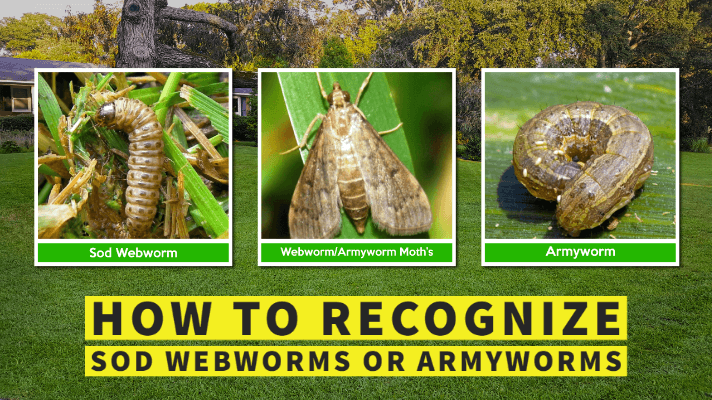Here is the moth I killed last night with soap spray - I saw about a dozen moths fly out of the grass when I mowed - this looks like the Sod Webworm "lawn moth."
If initial symptoms are already present in the turf, soil drenching can be done with a soap solution for monitoring and spot treatment of the pest. For this, add 1 ounce of dish detergent in 1 gallon of water and pour the solution over a 1-square-yard area where the infestation is suspected. This is called the “soap flush technique.” This soap solution should kill the caterpillars.
So I already sprayed some soap - on the lawn - but tomorrow I'll try this soil drenching technique for a 3 feet by 3 feet edge - of the dead grass -

https://extension.uga.edu/publications/detail.html?number=C1156
I had no idea what this was until I saw about a dozen small white moths fly off the lawn when I mowed - and they fly out of the dead grass! Then I realized they had "hatched" from larvae or caterpillars.
The soap flush technique can be used for larval control if the infestation is mild. Under circumstances where tolerance to pest damage is very low, intensified sampling should begin immediately after the moths’ flight activity is noticed. If infestation is detected, insecticides should be promptly used.
OK so then after tomorrow's Drenching experiment I will switch to a BT spray. There is only ONE "local" shop that sells this BT spray in STOCK. So I will get it tomorrow.
Bacillus thuringiensis var. kurstaki and aizawai (Thuricide) may help control sod webworm with minimum impact on the beneficial insects.
May? Let's how it's more than "may"!!
If you already have a sod webworm infestation, treat it with Bt (Bacillus thurigiensis). Bt is a biological control that will not harm you, your children, your pets, beneficial insects or the planet. It is however deadly for caterpillars.
https://www.nativenurseries.com/blog/safe-solutions-bt-for-sod-webworm
Because this pest feeds at night, an evening application is most effective. Sunlight breaks the product down, so do not expect it to continue to work for more than a few days. You will need to treat more than once. Although it takes a day or two for the larva to die after ingesting Bt, it loses its appetite right away and stops feeding on your lawn.
sounds promising!
My problem with spinosad is it is a non selective disease for all insects. BT seems to be limited to caterpillars. If you spray spinosad on the lawn, then all the microarthropods are goners. Spray BT on a lawn and all the caterpillars are goners. In your case the caterpillars are the pest and the only caterpillar in the lawn.
So BT is ideal.
1. Do not use chemical pesticides on your lawn. In fact, do not use any broad-spectrum pesticides on your lawn, chemical, natural or certified organic, if at all possible. A broad-spectrum pesticide kills pretty much everything. When you feel it’s absolutely necessary, try to choose a product that will target the pest in question. There are beneficial insects and spiders that feed on sod webworm (spiders, lady bugs, ground beetles, wasps and more). They can consume a lot of sod webworms if you do not kill them before they have a chance to do so.
2. A healthy lawn is less susceptible to sod webworm. You can improve the health of your lawn by watering adequately (but only when it needs it), by not over fertilizing, not over using pesticides or mowing too short. When you over fertilize, you might as well put out a neon sign, ‘Sod Webworm Buffet
So that's what happened - I used a ton of Corn Gluten Meal and it was a sunny spot - both favored the Sod Webworm Caterpillar immensely!!
I was going to dethatch that part of the lawn before - I will Dethatch tomorrow after I do the Soap Flush technique.
The Thatch rake should help clear out the caterpillars.
rake the lawn with a manual rake until little to no thatch emerges from the grass.
When they pupate, their cocoons can be seen in the upper thatch of
https://homeguides.sfgate.com/rid-sod-worms-grass-49240.html
Apply Bt toward dusk or at night so that sod webworms receive a direct dusting as they emerge from their dens; reapply weekly, as needed.
So I'm reading reviews of Bt to see if anyone reports success. The stuck smells bad - organic matter.
This product does appear to curtail the sod webworms from continuing to munch up the grass.
4 teaspoons to a gallon.
To rid our lawn from Sod worms. It did a good job and worth the cost. Follow the application directions and the suggested annual time to do it.
Bacillus thuringiensis subspecies kurstaki (Btk)
Bt produces crystal proteins during sporulation, called insecticidal delta-endotoxins. Different proteins work against different insects by attaching to specific binding sites in the insect’s gut. They only become active once dissolved in the alkaline gut environment. Once attached they form holes in the gut, which eventually leads to death. This process can take days but the insect stops eating soon after ingestion.
Common Name: Sod webworm. Scientific Name: Herpetogramma phaeopteralis Guenée Order: Lepidoptera. Description: Adult moths are dingy ...
Bacillus thuringiensis (Bt) is a Gram positive, spore-forming bacterium that synthesizes parasporal crystalline inclusions containing Cry and Cyt proteins, some of which are toxic against a wide range of insect orders, nematodes and human-cancer cells. These toxins have been successfully used as bioinsecticides against caterpillars, beetles, and flies, including mosquitoes and blackflies.
https://www.ncbi.nlm.nih.gov/pmc/articles/PMC4280536/
Bt strains synthesize Crystal (Cry) and cytolytic (Cyt) toxins, (also known as δ-endotoxins), at the onset of sporulation and during the stationary growth phase as parasporal crystalline inclusions (Figure 1). Once ingested by insects, these crystals are solubilized in the midgut, the toxins are then proteolytically activated by midgut proteases and bind to specific receptors located in the insect cell membrane [5,7], leading to cell disruption and insect death.




No comments:
Post a Comment